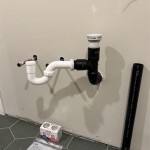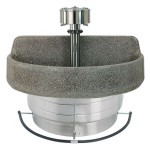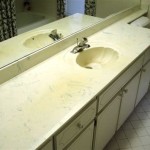How to Remove a Bathroom Faucet Handle
Removing a bathroom faucet handle is a common plumbing task often undertaken for repair, replacement, or aesthetic upgrades. Understanding the correct methods and tools can prevent damage to the faucet and surrounding plumbing, ensuring a smooth and efficient process. This article provides a comprehensive guide to removing various types of bathroom faucet handles.
Identifying the Faucet Handle Type
Before attempting removal, accurately identifying the type of faucet handle is crucial. Bathroom faucets generally come in several designs, each with a unique removal procedure. Common types include:
Single-Handle Faucets: These faucets control both hot and cold water with a single lever. The handle is typically secured with a setscrew or a cap covering a screw.
Double-Handle Faucets: Featuring separate handles for hot and cold water, these faucets often have handles secured with visible screws, hidden screws under decorative caps, or through a compression fitting mechanism.
Knob-Style Faucets: These handles are round and often ornate. Removal often involves locating a setscrew on the side of the knob or unscrewing the entire knob assembly.
Touchless Faucets: While the handle may be present for manual operation, the primary water control is sensor-based. Handle removal usually follows the same principles as single-handle or double-handle faucets, depending on the design.
Gathering Necessary Tools and Materials
Having the right tools readily available will streamline the removal process and minimize the risk of damage. Essential tools and materials include:
Screwdrivers: A set of screwdrivers, including both flathead and Phillips head varieties, is indispensable. The size and type of screwdriver will depend on the specific faucet handle design.
Allen Wrench Set: Many single-handle faucets use an Allen wrench (also known as a hex key) to loosen a setscrew that secures the handle. A set of varying sizes is necessary to find the correct fit.
Pliers: Slip-joint pliers or adjustable pliers may be needed to grip and loosen stubborn nuts or to remove decorative caps.
Penetrating Oil: If the handle is stuck or corroded, applying penetrating oil can help loosen it.
Soft Cloth or Towel: Placing a soft cloth between the pliers and the faucet handle can prevent scratches and other cosmetic damage.
Basin Wrench: A basin wrench is a specialized tool for reaching and loosening nuts and bolts in tight spaces beneath the sink. While not always necessary for handle removal itself, it may be required if the entire faucet needs to be removed for more extensive repairs.
Safety Glasses: Protecting the eyes from debris is essential during any plumbing task.
Work Gloves: Gloves provide a better grip and protect hands from sharp edges or contaminants.
Step-by-Step Removal Procedures for Different Handle Types
The following outlines the specific steps for removing various faucet handle types:
Single-Handle Faucet Removal (Setscrew Method)
Single-handle faucets with setscrews are among the most common. The following procedure should be followed:
Locate the Setscrew: The setscrew is typically located on the side of the handle, often concealed by a small cap or cover. Use a small flathead screwdriver or a pin to gently pry off the cap.
Loosen the Setscrew: Insert the appropriate size Allen wrench into the setscrew and turn it counterclockwise. Do not remove the setscrew completely; simply loosen it enough to release the handle. If the setscrew is corroded and difficult to turn, apply penetrating oil and allow it to sit for several minutes before attempting to loosen it again.
Remove the Handle: Once the setscrew is loosened, gently pull the handle straight up or away from the faucet body. If the handle is still stuck, try wiggling it slightly while pulling to break any corrosion or mineral buildup.
Single-Handle Faucet Removal (Screw Under Cap Method)
Some single-handle faucets have a decorative cap on top of the handle that conceals a screw. To remove this type:
Remove the Decorative Cap: Carefully pry off the decorative cap on the top of the handle. Use a small flathead screwdriver or a plastic putty knife to avoid scratching the finish.
Unscrew the Screw: Once the cap is removed, a screw will be visible. Use the appropriate size screwdriver (Phillips or flathead) to unscrew the screw. Turn counterclockwise to loosen it.
Remove the Handle: After the screw is removed, gently pull the handle straight up or away from the faucet body. Wiggling the handle slightly may be necessary to dislodge it.
Double-Handle Faucet Removal (Visible Screw Method)
Double-handle faucets often have a visible screw securing each handle. The process is straightforward:
Locate the Screws: Identify the screws on each handle, usually located on the top or side of the handle.
Unscrew the Screws: Use the appropriate size screwdriver to unscrew each screw. Turn counterclockwise to loosen.
Remove the Handles: After the screws are removed, gently pull each handle straight up or away from the faucet body. Wiggle the handles gently if they are stuck.
Double-Handle Faucet Removal (Hidden Screw Method)
Many double-handle faucets conceal the screws under decorative caps. The removal process is similar to the single-handle faucet with a cap:
Remove the Decorative Caps: Carefully pry off the decorative caps on top of each handle. Use a small flathead screwdriver or a plastic putty knife to avoid scratching the finish.
Unscrew the Screws: Once the caps are removed, screws will be visible. Use the appropriate size screwdriver (Phillips or flathead) to unscrew the screws. Turn counterclockwise to loosen.
Remove the Handles: After the screws are removed, gently pull each handle straight up or away from the faucet body. Wiggle the handles gently if they are stuck.
Knob-Style Faucet Removal
Removing knob-style faucet handles depends on their specific design. Some have setscrews, while others screw directly onto the valve stem.
Check for Setscrews: Inspect the knob's perimeter for a setscrew. If found, loosen it using the appropriate size Allen wrench, turning counterclockwise.
Unscrew the Knob (If No Setscrew): If no setscrew is present, the knob likely screws directly onto the valve stem. Rotate the knob counterclockwise to unscrew it. This may require a firm grip and some initial force.
Remove the Knob: Once the setscrew is loosened or the knob is unscrewed, gently pull the knob away from the faucet body.
Addressing Common Issues
Several common issues may arise during faucet handle removal. Understanding how to address these challenges can prevent frustration and potential damage.
Stuck or Corroded Handles: Corrosion and mineral buildup can cause handles to become difficult to remove. Applying penetrating oil liberally to the base of the handle and around any screws or setscrews can help loosen it. Allow the oil to soak for at least 15-30 minutes before attempting removal again. Gently tapping the handle with a rubber mallet can also help break the bond.
Stripped Screws: If a screw is stripped, it can be difficult to remove. Try using a rubber band or steel wool between the screwdriver and the screw head to provide better grip. Alternatively, a screw extractor tool may be necessary. Consider using a penetrating oil to help free the corroded screw before attempting to remove it.
Broken Handles: If a handle is already broken or cracked, extra care must be taken to avoid further damage. Use pliers to carefully grip any remaining pieces and gently twist or pull them away from the faucet body. Be mindful of sharp edges.
Damaged Faucet Finish: To prevent scratching or damaging the faucet finish, always use a soft cloth or towel between the faucet and any tools, such as pliers. Applying masking tape or painter's tape around the base of the handle can also protect the surrounding area.
Post-Removal Considerations
After removing the faucet handle, several considerations are important before proceeding with the repair, replacement, or upgrade.
Inspect the Valve Stem: Examine the valve stem for any signs of damage or wear. Replace the valve stem if it is corroded, bent, or otherwise compromised. This is essential for ensuring proper faucet function and preventing leaks.
Clean the Faucet Body: Clean the area around the faucet body to remove any mineral deposits, soap scum, or debris. This will ensure a clean and smooth surface for the new handle or faucet components to be installed.
Identify Replacement Parts: If replacing the handle or other faucet components, carefully identify the correct replacement parts. Take the old handle or component to a hardware store or plumbing supply store to ensure a proper match. Note the model number of the faucet if available.
Reassemble Carefully: When reassembling the faucet, ensure that all parts are properly aligned and tightened. Avoid over-tightening screws or nuts, as this can damage the faucet or strip the threads. Follow the manufacturer's instructions for reassembly.
By following these steps and guidelines, removing a bathroom faucet handle can be accomplished safely and efficiently, whether for routine maintenance or more extensive plumbing repairs. This detailed approach increases the likelihood of a successful outcome and prevents potential damage to the plumbing system.

How Do I Replace Bathroom Sink Faucet Handles Cleaning More

How To Remove Moen Bathroom Faucet Handle In 2 Steps

How To Remove And Install A Bathroom Faucet

Tips Tricks Remove Delta 2 Handle 4 In Bathroom Sink Faucet With Bar 5 21 18

How To Tighten Faucet Handle Homeserve Usa

Help Removing Bathroom Faucet Handle Doityourself Com Community Forums

How To Fix A Leaking Faucet Without In The Handle Moen

How To Remove Faucet Handles Doityourself Com

How To Remove Kitchen Bathroom Faucet Handle Without S

How To Change The Handle Rotation On A Faucet
Related Posts







